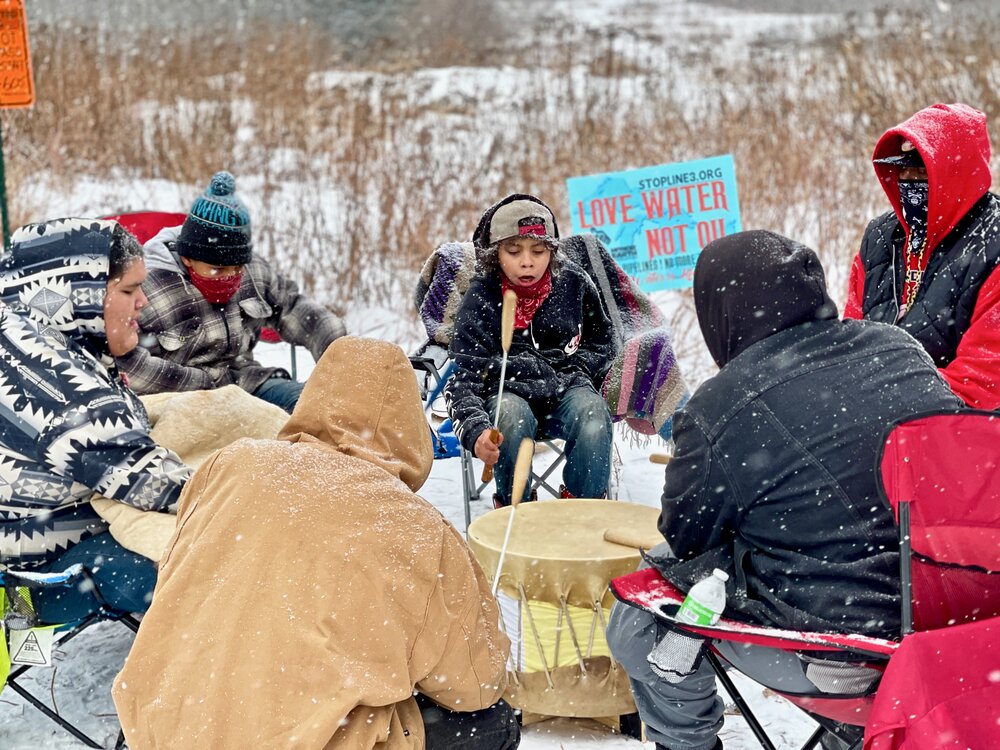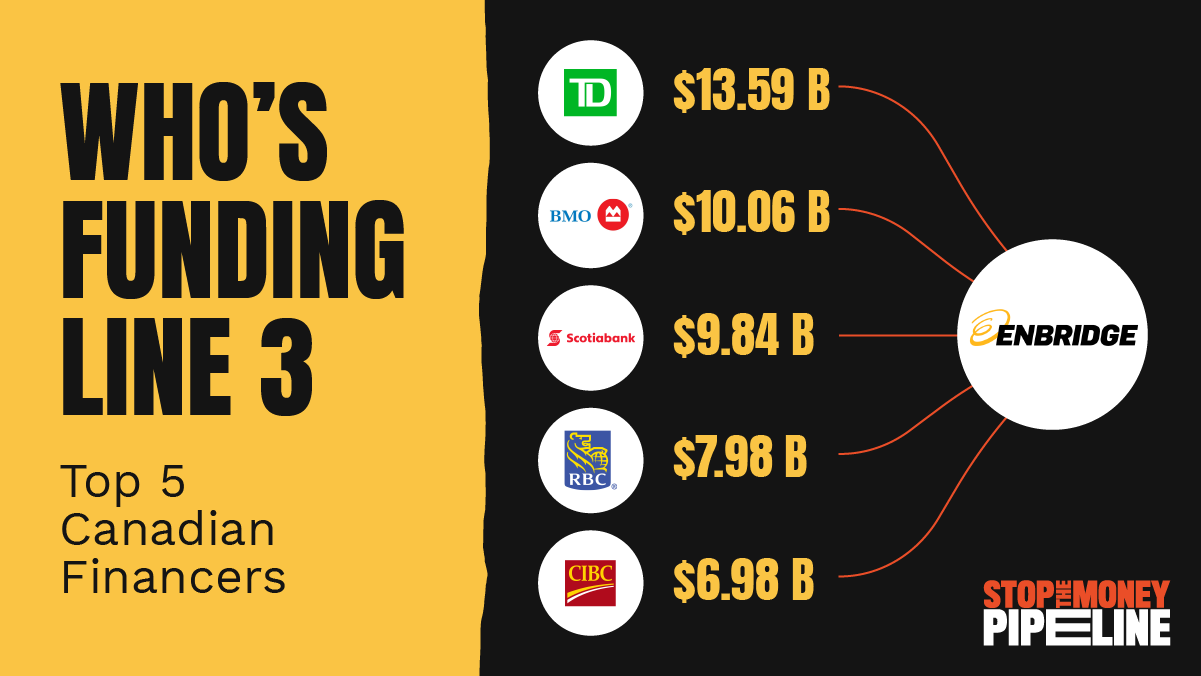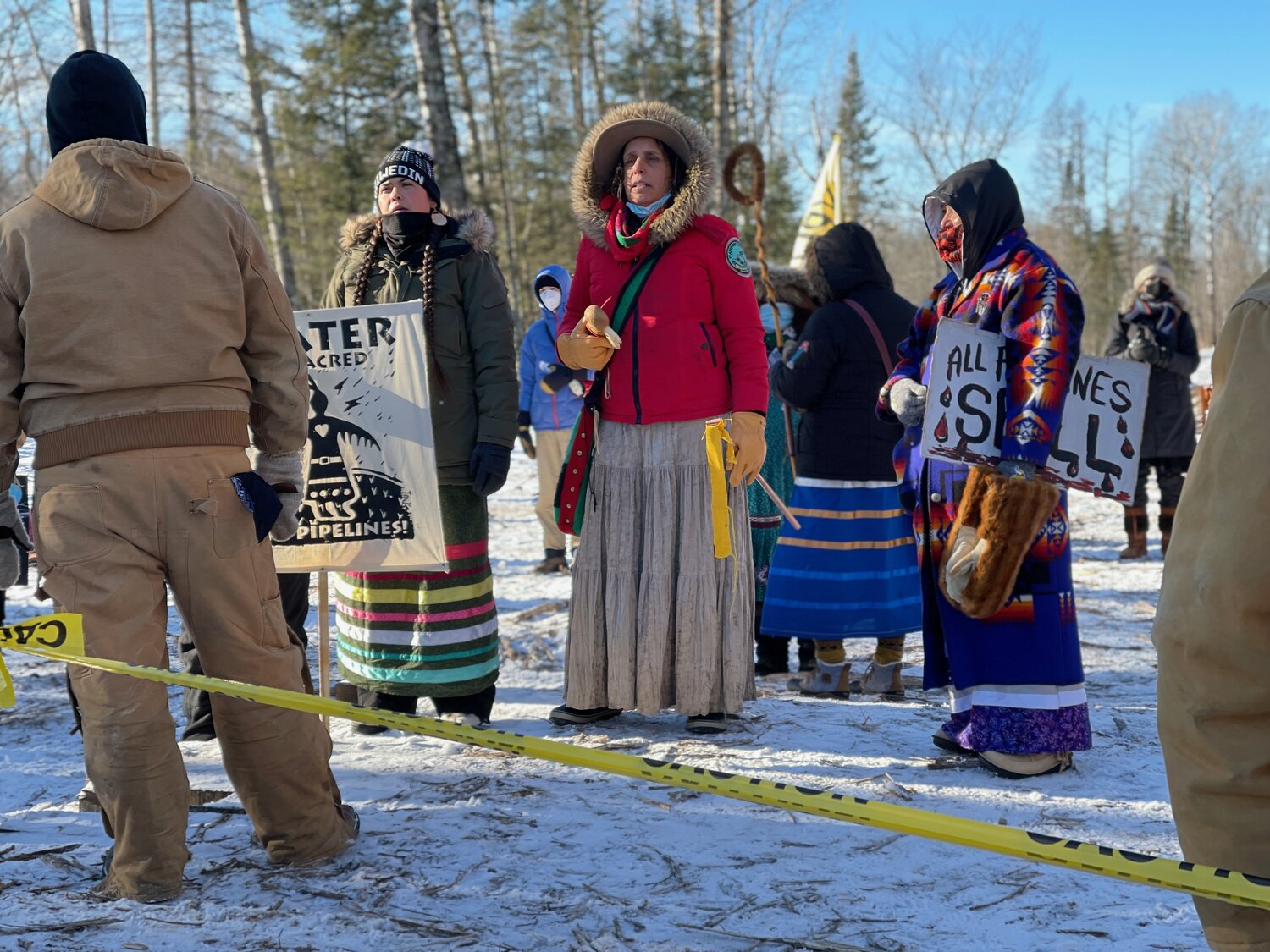Update (Sept. 29, 2021): Enbridge announced on Sept. 29, 2021 the completion of construction of Line 3, which the company said would go into service on Oct. 1, 2021. (source)
Like its infamous cousin Keystone XL, the proposed Enbridge Line 3 replacement project is a major tar sands pipeline that would catalyze more production of the dirtiest and highest carbon form of oil – the Athabasca tar sands. Since construction on the line began in late 2020, resistance along the route has led to arrests and actions on a weekly basis, led by Indigenous Water Protectors of the Anishinaabe nations in northern Minnesota.
Billed as a “replacement” project, Line 3 as currently proposed is actually a brand new pipeline route, largely following the path of Enbridge’s rejected Sandpiper pipeline. Far from the original pipeline route — except at the Canadian border crossing and the terminus — the new route crosses unique wild rice (manoomin) growing areas that are supposed to be legally protected for the tribal nations of the region. The Canadian segment of the Line 3 replacement was completed and entered service in December 2019. In the U.S, the $2.9-billion replacement would consist of replacing existing 34-inch pipe with new 36-inch pipe for 13 miles in North Dakota, 337 miles in Minnesota, and 14 miles in Wisconsin. The Wisconsin portion was completed in 2018, and construction on the Minnesota segment began in December 2020 with expected completion in the fourth quarter of 2021.
Enbridge, Canada’s largest pipeline company, is by far the largest transporter of tar sands crude from Canada to the United States. Its mainline system is a complex of pipelines with capacity to bring at least 2.5m barrels per day through Minnesota to refineries in the Midwest. While Canada portrays itself as a climate leader, it remains committed to expanding its tar sands industry, even though tar sands is the highest carbon and most expensive form of oil. Enbridge is a big player in that planned expansion.
The campaign against the expansion of the Enbridge tar sands pipeline system has been going on for a decade. As early as 2009, tar sands campaigners were fighting the presidential permit for its Alberta Clipper pipeline, in a precursor to the Keystone XL campaign.
The campaign has seen its share of victories — for example, the announced closing of the Line 5 pipeline in Michigan, and the cancellation of the Sandpiper pipeline in Iowa and Minnesota. The campaign has also experienced losses — notably the permitting of the Line 67 pipeline via a dubious, grandfathered cross-border Presidential Permit. That Presidential Permit was opposed vigorously, but the campaign was unable to recreate the dynamic of the Keystone campaign, and its pleas fell on deaf ears at the Kerry State Department.
The years-long campaign against Line 3 is a crucial part of the larger overall campaign to keep tar sands in the ground, because it is the most attractive remaining avenue for long-term expansion of export capacity to the US. (Rail transport is short-term, and KXL is unlikely to move forward under a Biden Administration.) Line 3 benefits from an existing Presidential Permit for the cross-border section, and therefore the campaign has focused on Minnesota state authority for stopping the pipeline, rather than federal authority.
Successive Democratic Governors, including Governor Walz today, have been ambivalent. Faced with pro-pipeline pressure from unions, and anti-pipeline pressure from Tribes and environmentalists, they have fallen back on process. The Minnesota Dept. of Commerce has been an ally, but their influence seems to have waned in favor of the Public Utilities Commission.
Construction is on hiatus until early June, with Enbridge expected to resume with special attention to horizontal directional drilling at river crossings on the Mississippi River. Minnesota state courts are expected to issue ruling on challenges to state permits during the summer of 2021, which could potentially lead to injunction to stop construction.
Despite a summer of intense Indigenous-led resistance across multiple camp sites that stopped construction with a series of acts of peaceful, nonviolent civil disobedience that led to more than 800 arrests — including the Treaty People Gathering that led thousands to convene on Minnesota to participate — Enbridge continued with construction that was completed on Sept. 29, and Line 3 was put into operation on Oct. 1.
Recent Media Coverage
- (Sept. 29, 2021): MPR: Enbridge says Line 3 replacement complete, opens Friday
- (Aug. 5, 2021): Minneapolis Star Tribune: New front in Line 3 legal fight: Wild rice is plaintiff in lawsuit against DNR
- (May 4, 2021): The Circle News: The Water Protector Spring is coming
- (April 9, 2021): CNN: The pipeline that President Biden needs to stop (by Rep. Ilhan Ohmar & Tara Houska)
- (March 25, 2021): Vox: The Indigenous-led fight to stop the Line 3 oil pipeline expansion in Minnesota, explained
- (April 23, 2020): Rolling Stone: The Fight Against Minnesota’s Line 3 Pipeline: Bill McKibben and Winona LaDuke in Conversation
- (December 22, 2020) MintPress News: Could the Next Standing Rock Be Brewing in Northern Minnesota?
Project Details
- Operator: Enbridge
- Proposed capacity: 370,000 (current) > 760,000 total barrels per day (“replacement”)
- Length: 665 replacement miles
- Status: OPERATING
- Start Year: 2021
- Bank lenders: JP Morgan, Bank of America, Wells Fargo
- December 2020: Who’s Banking Line 3 and Keystone XL? (Rainforest Action Network)
Project Status
Eminent Domain:
- The original pipeline was constructed in 1967. Landowners have mostly (94% in 2017) agreed to allow the replacement project, along a substantially different route, while Enbridge did not require new agreements with landowners on its existing “Enbridge Mainline System” pipeline corridor.
- Some landowners on the original Line 3 route are negotiating with Enbridge for removal of pipe from their property. Enbridge says full removal cost would be $1.2 billion.
Indigenous Free, Prior & Informed Consent; Consultation & Environmental Justice:
- No free, prior & informed consent. Free, Prior and Informed Consent (FPIC) is a specific right that pertains to Indigenous peoples and is recognized in the United Nations Declaration on the Rights of Indigenous Peoples (UNDRIP). It allows them to give or withhold consent to a project that may affect them or their territories. Once they have given their consent, they can withdraw it at any stage. Furthermore, FPIC enables them to negotiate the conditions under which the project will be designed, implemented, monitored and evaluated. This is also embedded within the universal right to self-determination. [source]
- August 2018: Enbridge reaches agreement with the Fond du Lac Band of Lake Superior Chippewa, granting a new 20-year easement for the entire Mainline, including the Line 3 Replacement Project, through its reservation.
- Several Tribal Nations filed suit against MN agencies over pipeline approvals: White Earth Band of Ojibwe, Red Lake and the Mille Lacs Band, challenging the Routing Permit and EIS specifically around some of the cultural resources survey issues.
Outstanding Permits:
- November 2020: Enbridge received a set of permits from Minnesota regulators that will allow it to push ahead with its Line 3 replacement project. The approvals clear the way for the U.S. Army Corps of Engineers to issue the remaining federal permits for the project.
- Minnesota Pollution Control Agency (MPCA)
- November 23, 2020: Enbridge obtains federal permits from the U.S. Army Corps of Engineers and that construction of the pipeline could now begin.
- Dec. 1, 2020: Line 3 construction begins in Minnesota, with an expected completion date of Q4 2021.
Impact Litigation / Court Fights
The court fights revolve around a failure of the federal government to follow proper eminent domain process, and clean water laws.
Federal Court:
- February 2021: Federal court denies request for injunction to shut down construction; decision on merits of case expected mid-2021. [source]
State Court:
- April 2021: Panel of Appellate Court administrative law judges hears arguments over adequacy of the certificate of need and environmental impact statement granted to Line 3 by MN PUC from Dept. of Commerce, MN PUC, Enbridge; Red Lake Nation, White Earth Nation, Honor the Earth and the Sierra Club also joined DOC’s appeal. Ruling expected within 90 days. [source]
- February 2021: Minnesota Court of Appeals denies request by the Red Lake Band of Chippewa and the White Earth Band of Ojibwe to shut down construction of the project in northern Minnesota. The American Indian tribes said in their petition that construction would destroy land that is protected by treaty agreements and would violate cultural and religious rights. Other cases seeking to halt the project’s construction remain in the appeals court. [source]
[Select information and map data excerpted from Global Energy Monitor, with permission and Creative Commons license.]





